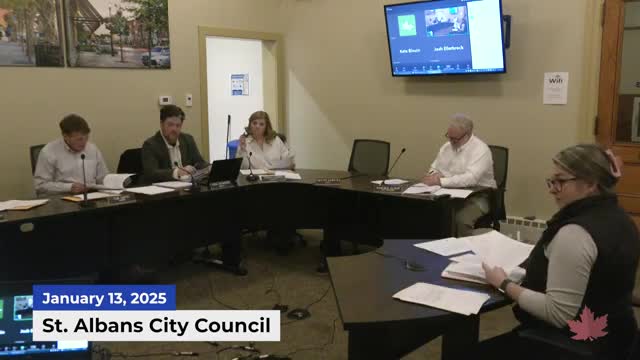St. Albans council weighs $6.8M plan to store storm overflows underground at Houghton Park
January 16, 2025 | St. Albans City, Franklin County, Vermont
This article was created by AI summarizing key points discussed. AI makes mistakes, so for full details and context, please refer to the video of the full meeting. Please report any errors so we can fix them. Report an error »

St. Albans City Council members reviewed a proposal to build underground storage tanks at Houghton Park to reduce combined sewer overflows (CSOs) that now back up at the low point of the system, the intersection of South Elm and Lower Weldon.
The council heard that the project would create roughly 500,000 gallons of storage in reinforced vaults beneath turf at the park and allow staff to hold stormflows and release them at a controlled rate when the treatment plant can accept them. City staff described the storage as sized to eliminate the majority of overflow events recorded over the past six to seven years.
City Manager/Staff and engineering consultants told the council the current conservative construction estimate is about $6.8 million. The city has about $2.8 million in state ARPA funds available, expects roughly $1.0 million in forgivable planning/design grant funding from the state revolving fund (SRF), and would need additional SRF loans or bonding to cover the balance.
Sarah, director of finance and administration, said the city would draw grant and loan sources together and that SRF rules would require the full financing package to be described in the bond language. She said the city would likely need to seek voter approval for a bond and described a conservative budget and schedule to use grant funds before their expiration in late 2026.
Public Works staff described the engineering approach and maintenance access: the vaults would be in a long, narrow footprint beside Lower Weldon, built so trucks can access launch/cleaning points and a trash pump will remove settled solids. Staff said routine maintenance would be part of the operations plan.
Councilors asked whether the city should build larger storage now to plan for future climate-driven events. Staff said the chosen 500,000‑gallon design matches available space at Houghton Park without disrupting the adjacent football field and that the design could be expanded later or supplemented by other sites if needed.
Council discussion also covered timing: staff said it is feasible to complete design and construction while preserving eligibility for available grants if the council moves quickly. Several councilors asked for more detail on per‑household cost and on how contaminated soils would affect final bids and total cost.
The council discussed whether to include a bond question on an upcoming warning. Members asked staff to refine cost and timeline details and to continue seeking additional grants; staff said they would return with recommended bond language and fiscal impact estimates for voters.
Ending: Council members signaled general support for placing the project before voters once staff returns with final financing language and a clearer schedule, and asked staff to pursue any additional grant funds and to provide a clearer household cost estimate before a final vote.
The council heard that the project would create roughly 500,000 gallons of storage in reinforced vaults beneath turf at the park and allow staff to hold stormflows and release them at a controlled rate when the treatment plant can accept them. City staff described the storage as sized to eliminate the majority of overflow events recorded over the past six to seven years.
City Manager/Staff and engineering consultants told the council the current conservative construction estimate is about $6.8 million. The city has about $2.8 million in state ARPA funds available, expects roughly $1.0 million in forgivable planning/design grant funding from the state revolving fund (SRF), and would need additional SRF loans or bonding to cover the balance.
Sarah, director of finance and administration, said the city would draw grant and loan sources together and that SRF rules would require the full financing package to be described in the bond language. She said the city would likely need to seek voter approval for a bond and described a conservative budget and schedule to use grant funds before their expiration in late 2026.
Public Works staff described the engineering approach and maintenance access: the vaults would be in a long, narrow footprint beside Lower Weldon, built so trucks can access launch/cleaning points and a trash pump will remove settled solids. Staff said routine maintenance would be part of the operations plan.
Councilors asked whether the city should build larger storage now to plan for future climate-driven events. Staff said the chosen 500,000‑gallon design matches available space at Houghton Park without disrupting the adjacent football field and that the design could be expanded later or supplemented by other sites if needed.
Council discussion also covered timing: staff said it is feasible to complete design and construction while preserving eligibility for available grants if the council moves quickly. Several councilors asked for more detail on per‑household cost and on how contaminated soils would affect final bids and total cost.
The council discussed whether to include a bond question on an upcoming warning. Members asked staff to refine cost and timeline details and to continue seeking additional grants; staff said they would return with recommended bond language and fiscal impact estimates for voters.
Ending: Council members signaled general support for placing the project before voters once staff returns with final financing language and a clearer schedule, and asked staff to pursue any additional grant funds and to provide a clearer household cost estimate before a final vote.
View full meeting
This article is based on a recent meeting—watch the full video and explore the complete transcript for deeper insights into the discussion.
View full meeting